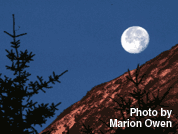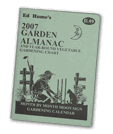
Planting by the Moon
May the Force be with you while sowing seeds, mowing
the lawn, pruning roses, composting, watering and more!
By Marion Owen, Fearless Weeder
for PlanTea, Inc. and
Co-author of Chicken Soup for the Gardener's Soul
FEATURE ARTICLE:

Tom Hanks' "Power of Four" solution
More good stuff:
Who is Marion Owen?
FAQs about PlanTea
Search Marion's articles, tips and recipes
Why grow organic?
News and press releases
Read love letters
How to link to this site
Need a speaker?
How to contact Marion
Visiting Alaska?
Come to Kodiak Island!
Go to home page

Marion's UpBeet Gardener
Newsletter has been
replaced by Marion's blog
which you can find at:
www.marionowen.wordpress.com
 What if I told you that mowing your lawn on certain days would mean you could mow less often?
What if I told you that mowing your lawn on certain days would mean you could mow less often?
Before you roll your eyes, think about it. The moon influences more than the ocean tides. Just ask any bartender, clergyman or nurse. In fact, my friend Amy braces herself before going to work. Amy works at the hospital and when the moon is full, those nights in the emergency room are, as she calls it, "memorable."
Many scientists insist that the myth that a full moon affects the behavior of humans, animals and plants is a bunch of baloney. But police, bartenders and folks like Amy will tell you otherwise.
Before I go further, let me tease you with a possibility: What if mowing your lawn during certain phases of the moon retarded growth which meant you didn't have to mow as often? Keep reading. I bet you won't be shaking your head much longer!
According to a National Geographic news article more gardeners today are turning to the moon for sage advice on the best time to plant, prune, weed, and harvest. The practice, known as moon or lunar gardening, centers on the moon's gravitational effect on the flow of moisture in soil and plants.
Gardening by the moon is as old as time. Long before man (and women!) ever had a watch on his wrist or a calendar on the refrigerator, everything was governed by the phases of the moon.
May the Force be with you!
 Moon
gardening has been passed down through many generations. "There are
firm believers in moon gardening today who will not plant anything unless
a favorable moon sign is indicated," says Ed Hume, one of the Pacific
Northwest's favorite garden gurus and proponent of the moon's influences
on gardening. Hume publishes an annual Garden Almanac which gives month
by month moon sign gardening calendar -- you can buy
your own Almanac through my online catalog.
Moon
gardening has been passed down through many generations. "There are
firm believers in moon gardening today who will not plant anything unless
a favorable moon sign is indicated," says Ed Hume, one of the Pacific
Northwest's favorite garden gurus and proponent of the moon's influences
on gardening. Hume publishes an annual Garden Almanac which gives month
by month moon sign gardening calendar -- you can buy
your own Almanac through my online catalog.
The moon controls ocean tides, influences the groundwater tables beneath our feet and the movement of fluids in plants. Even continental land masses are said to rise 2 to 3 feet in elevation with the passage of the moon. Understanding the effects, and timing your gardening chores accordingly, is the basis of moon gardening.
|
Ed Hume's Garden Almanac serves as a handy reference guide for the best dates for sowing seeds, pruning, tending houseplants, transplanting, and fertilizing. Dates are included for watering, composting, harvesting, and even when to mow the lawn to retard growth! There is a wealth of information in the Garden Almanac. It's like knowing "the Force is with you!" |
For example, the best time to turn over garden soil is during the last quarter of the moon (decreasing moon phase) because that's when the water table has dropped to its lowest point. This means there is less moisture in the soil. Taking your back into consideration, it is easier to turn soil over when there is less moisture in it!
How to garden by moon phases
The moon moves through a complete cycle every 29 days. For moon gardening purposes, this cycle is divided into four quarters or phases. The term phase refers to the moon's apparent shape as viewed from earth during the month. To plant by the moon phases you will need an almanac or calendar, such as Ed Hume's Planting Guide, that lists the exact time and date of the moon phases.

The lunar month starts with the new moon, also called "the dark of the moon. From the new moon to the first quarter and from the first quarter to the full moon, the moon appears to grow from nothing to a crescent and then to a full circle at mid-month. These are the increasing or waxing phases.
Increasing
Light -- New moon to full moon
Examples of garden chores to do by the light of the moon:
(NOTE: These are general guidelines. I highly recommend referring to Ed
Hume's Planting Guide for specific planting tasks):
- Repot and groom houseplants
- Sow seeds of plants that grow above ground (for helpful tips on starting your own seeds, click here.)
- Fertilize
- Graft fruit trees
- Plant evergreen and deciduous trees
 The
decreasing or waning phases are when the moon "shrinks" from
the full moon down to the new moon (darkness). As the moon wanes during
the 3rd and 4th quarters, this is a good time to prune plants, as the
water table is diminishing and so less sap will flow out of the cut ends.
The plants are said to orient themselves toward their roots, making this
a favorable time for planting, transplanting and harvesting root crops
in general. The 4th quarter is the most dormant period and is good for
chores like weeding.
The
decreasing or waning phases are when the moon "shrinks" from
the full moon down to the new moon (darkness). As the moon wanes during
the 3rd and 4th quarters, this is a good time to prune plants, as the
water table is diminishing and so less sap will flow out of the cut ends.
The plants are said to orient themselves toward their roots, making this
a favorable time for planting, transplanting and harvesting root crops
in general. The 4th quarter is the most dormant period and is good for
chores like weeding.
Decreasing
Light -- Full moon to dark of the moon
Examples of garden chores to do by the dark of the moon:
(NOTE: These are general guidelines. I highly recommend referring to Ed
Hume's Planting Guide for specific planting tasks).
- Plant bulbs
- Plant crops that grow below the ground, such as potatoes, carrots
- Cultivate weeds
- Plant biennials and perennials because they need strong roots
- Eliminate slugs
- Prune shrubs
 How
is sowing, transplanting and harvesting linked to phases of the moon?
One theory is that during the light (waxing) of the Moon, sap is thought
to flow more strongly, filling plants with vitality and energy, favoring
the planting and harvesting of crops that mature above ground.
How
is sowing, transplanting and harvesting linked to phases of the moon?
One theory is that during the light (waxing) of the Moon, sap is thought
to flow more strongly, filling plants with vitality and energy, favoring
the planting and harvesting of crops that mature above ground.
What the moon gardening movement currently lacks is a body of modern scientific work that validates its benefits...
Science or baloney?
John Teasdale, director of the U.S. Department of Agriculture's Agricultural Systems Laboratory in Beltsville, Maryland, said he is not aware of any research on the lunar influences on agriculture, though he said an experiment could be established.
"We know that the moon influences some natural phenomena such as tides," he said. "I would guess that a simple hypothesis would be that lunar cycles could influence meteorological cycles which in turn could influence crops."
RJ Harris, the head gardener at a private estate near Cornwall, England conducts his own experiments. Each year he cultivates a selection of crops in opposition to the best practices of moon-gardening methods. Crops planted according to the lunar cycle fare much better, he said.

"I've got a large area in potatoes. We've got some planted at the right time of the moon and some crops at the wrong time of the moon. The difference is so obvious and there for everybody to see," he said.
Names
of full moons
January:
Wolf
February: Snow, Quickening, Storm
March: Worm, Sap, Chaste
April: Seed, Pink, Grass, Sprouting, Wind
May: Flower, Corn Planting, Hare
June: Strong, Rose, Sun, Strawberry
July: Mead, Thunder, Buck
August: Sturgeon, Wort, Corn
September: Barley, Harvest
October: Hunter's, Blood
November: Mourning, Beaver
December: Cold, Oak, Long Night's
Now it's your turn. Test the validity of gardening by the moon in your own garden. Plant some crops by the correct moon sign and others by the wrong moon sign. Experiment with above ground and below ground crops. Try mowing different parts of your lawn according to the moon phases! Send me you results, either by email or, better yet, send my a photograph. I'll send you a set of my photo note cards and a free box of PlanTea organic fertilizer.
|
For the present let the moon shine brightly and the breezes of the spring blow gently, dying away from the gale of the day, and let the earth, who brings increase, bring peace. --E.M. Forster |
Thanks for visiting and please stop by again. I'll put the coffee on!
Meet Marion Owen /// Learn about PlanTea /// Online Catalog /// Articles, Tips, Recipes /// Get free UpBeet Gardener newsletter /// Read current issue /// Listen to radio show /// Read news and press releases /// More resources and links /// Learn why 'grow organic?' /// View guidelines for retailers /// Read love letters /// Book Marion as a speaker /// Site map /// How to link to us /// Contact us /// Go to home page
PlanTea: The organic plant food in tea bags. http://www.plantea.com
Copyright ©1996 to present: PlanTea, Inc. All Rights Reserved. PO Box 1980, Kodiak, AK 99615-1980 USA
Questions or comments? marion@plantea.com Phone: Toll Free: 1-800-253-6331 (US and Canada); 907-486-2500